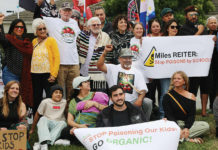
WATSONVILLE—A group of residents from Watsonville’s senior neighborhoods gathered at the Pajaro Village Club House last week to hear a presentation on pesticide use, and on an upcoming pilot project to notify residents on nearby applications.
Hosted by the Center for Farmworkers Families, Safe Ag Safe Schools, and the Campaign for Organic Regenerative Agriculture (CORA), issues addressed included amounts of pesticides used, ideal notifications components and the public’s right to know. Converting more Pajaro Valley farmland to organic and regenerative farming, reducing one’s carbon footprint and composting were also covered.
Retired PVUSD School Nurse Kathleen Kilpatrick used large display boards to explain California’s pesticide use reporting system. The Department of Pesticide Reform collects the data, while another organization, Tracking California, plots it on maps by county, township, and section, color coded by relative weight. The maps showed tight proximity of homes and schools to farmlands around the Pajaro Valley, a central topic of the meeting Saturday. There were examples of neighborhood and regional maps, tables, and trend graphs from the mapping tool showing relative poundage of all pesticides, carcinogens, and one pesticide, malathion, used in 2018, the last year data was available.
Former farmer, farmworker, and Special Ed teacher Woody Rehanek spoke of shortfalls in Watsonville’s climate action plan, and of converting local farmland to more regenerative practices that draw down and hold carbon in the soil, as well as enhancing its fertility and moisture retention.
“We have a problem in this section where we live,” he said. “For one thing, our use data is four years old. In 2018, there were 44,400 pounds of pesticides applied inside of this square mile where we live (Pajaro Village, Bay Village and Pajaro Vista). We have to ask why they would be applying 31,400 pounds of fumigants near a senior neighborhood.”
He added that Santa Cruz County has by far the highest percentage of fumigant use in the state, 67% of total pesticide poundage in 2018.
The presentation included words from Dr. Ann Lopez who offered stern warnings about the effects of hazardous agricultural chemicals, especially to farmworkers and their families, whom she has been helping for decades.
A presentation by Juan Hidalgo, Santa Cruz County Ag Commissioner, geared to provide specifics on the upcoming pilot notification project, will be held May 24 at 4:30pm at the clubhouse, 739 Bronte Ave.
A map of the area to be included was yet not available, but it is reported to center around the senior neighborhoods, may include nearby schools, businesses and homes.











